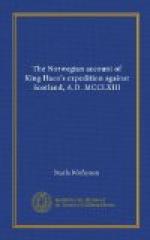[Footnote 20: i.e., an eminence, near Bergen.]
[Footnote 21: By banks of oars we are only to understand benches for the rowers.]
[Footnote 22: i.e., Cape-bay, near Bergen.]
[Footnote 23: An island and excellent harbour near Bergen.]
[Footnote 24: A celebrated poet, uncle to Sigvat Bodvarson, who attended Haco in this expedition, and from whom Sturla probably had his information of facts.]
[Footnote 25: The most northerly province of Norway.]
[Footnote 26: i.e., no warrior.]
[Footnote 27: The Scandinavian Scalds and Mythologists often represented treasures as guarded by monsters, dragons, sea snakes, &c. This notion probably originated from the fabulous tales of those who traded to the Indies. An ancient author, speaking of Scythia, says, “nam qvum in plerisque locis auro & gemmis affluant, Gryphorum immanitate, accessus hominum rarus est.”]
[Footnote 28: i.e., Haco.]
[Footnote 29: i.e., ships.]
[Footnote 30: Gestil, a famous sea king or pirate.]
[Footnote 31: Thareyiar-fioerd (orig.), perhaps a mistake for Faroeyiar-fioerd. Torfaeus read it Barreyiarfiord.]
[Footnote 32: i.e., the column of pillars, perhaps the island Staffa.]
[Footnote 33: i.e., the promontory of deer, now Durnish.]
[Footnote 34: 7th of July.]
[Footnote 35: The Norwegians computed by winters: the Scotch did the same, as we see by Winton’s chronicle:
“Thretty winters
and four than
Edan regnyd Max Gowran.”
]
[Footnote 36: Val-drosar (orig.), the Goddesses of Fate, or Valkyriae, to whom armour was supposed sacred.]
[Footnote 37: i.e., Tribute—Ringa elldingom, (orig.), bright rings: Ringa signify not only rings, or bracelets, but also money; for before the introduction of coinage into the North, very thick spiral gold wires were worn round the wrists of great men, who distributed bits to those who performed any signal service; and such a wire is still to be seen in the Royal Museum at Copenhagen. It is not always easy to discern when by ringa is understood ornaments for the fingers, bracelets, rings of investiture, or the current money of the times.]
[Footnote 38: i.e., the islet, a monastery near Bergen.]
[Footnote 39: Afterwards chancellor of Norway.]
[Footnote 40: Probably the son of Dugal, the son of Somerled.]
[Footnote 41: The father of King Dugal was Rory, I suppose. See notes on pages 34 and 42.]
[Footnote 42: Nephew to Sturla author of the Ravens-ode. He attended Haco in this expedition.]
[Footnote 43: i.e. ships.]
[Footnote 44: i.e. sails.]
[Footnote 45: Bla-dufor (orig.), i.e. Blue pigeons. The Scalds frequently compared ships under sail to birds, horses, and other animals in motion.]




